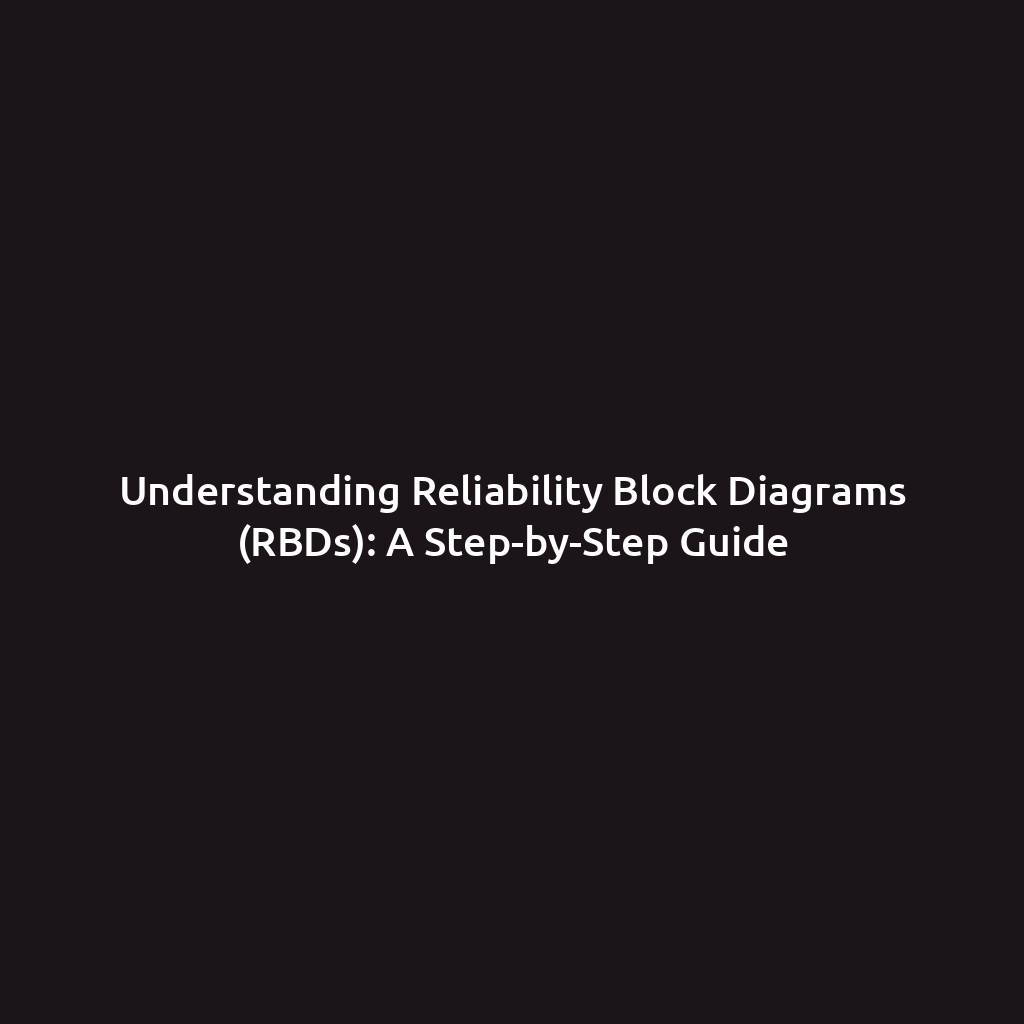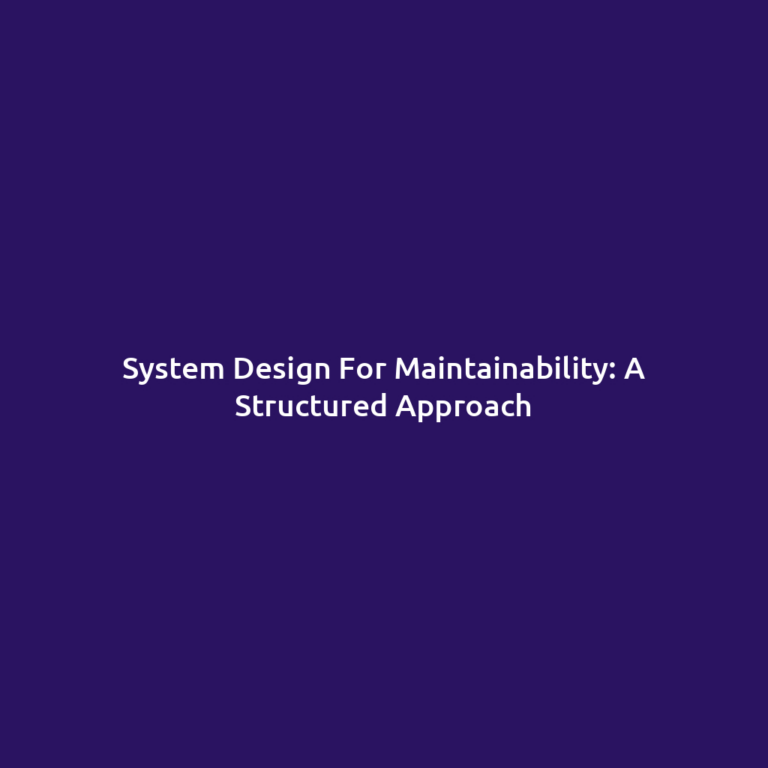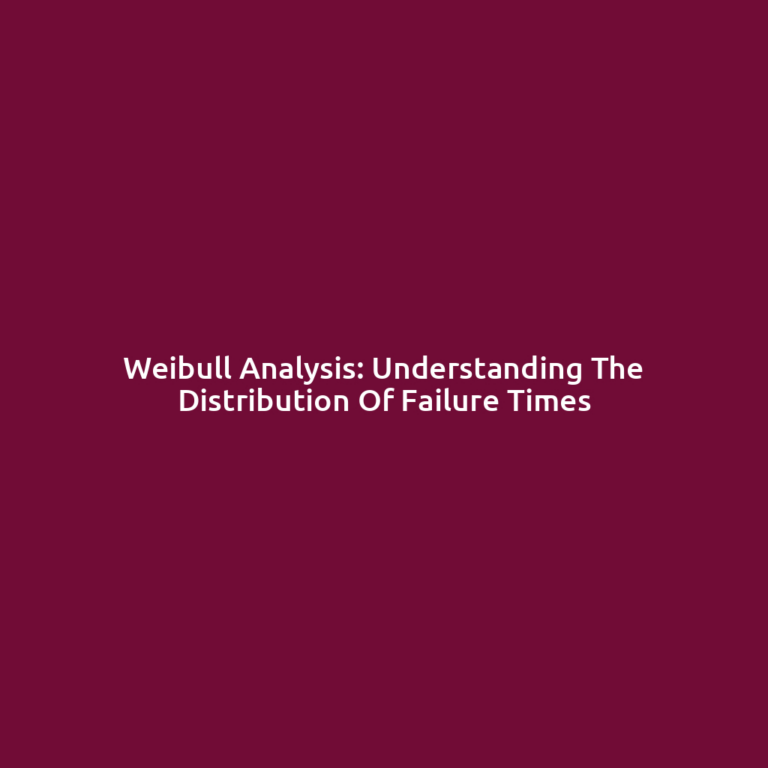Understanding Reliability Block Diagrams (RBDs): A Step-by-Step Guide
Imagine building a bridge where every brick plays a crucial role. Similarly, Reliability Block Diagrams (RBDs) represent the components of a system and how they work together to ensure overall reliability. These visual tools allow engineers to model systems, evaluate performance and identify potential weak links. But why are RBDs so impactful in engineering and how do they make complex systems more comprehensible?
Reliability Block Diagrams are graphical representations that map out the reliability relationships between various components in a system.
These diagrams help predict system behavior under different scenarios, enabling teams to design for maximum efficiency. Let’s break down their structure and utility to understand their transformative power.
Table of Contents
- 1 Why Do Engineers Use RBDs?
- 2 Key Components of Reliability Block Diagrams
- 3 How to Construct an RBD
- 4 Analyzing Reliability Block Diagrams
- 5 Applications of RBDs Across Industries
- 6 Key Advantages of Using RBDs
- 7 Challenges in Implementing RBDs
- 8 Best Practices for Effective RBDs
- 9 Frequently Asked Questions (FAQs) About Reliability Block Diagrams (RBDs):
Why Do Engineers Use RBDs?
Reliability Block Diagrams are pivotal in industries where performance and safety are paramount. Whether it’s logistics, healthcare or manufacturing, RBDs enable engineers to:
-
Pinpoint vulnerabilities in systems.
-
Assess overall system reliability.
-
Optimize maintenance schedules.
-
Make informed decisions during the design phase.
Consider a power grid. An RBD can show which generators, transformers and lines are critical for uninterrupted power supply. Without these insights, identifying failure points becomes a guessing game.
Key Components of Reliability Block Diagrams
To master Reliability Block Diagrams, it’s essential to understand their building blocks:
-
Blocks: Represent individual components or subsystems.
-
Connections: Define how blocks interact-in series or parallel.
-
Paths: Illustrate possible operational routes ensuring clarity in complex systems.
The configuration of blocks – whether in series, parallel or a combination-directly impacts system reliability. Understanding these configurations is vital for interpreting and leveraging RBDs effectively.
Series Configurations: The Weakest Link Matters
In a series setup, every block must function for the system to succeed. Think of holiday lights: if one bulb fails, the entire string goes dark. While series configurations are simple, their reliability depends on the least reliable component.
Parallel Configurations: Building Redundancy
Parallel configurations offer a safety net. Here, multiple blocks perform the same function, ensuring the system works even if one block fails. Imagine a backup generator kicking in during a power outage.
Parallel setups enhance reliability but may involve higher costs and complexity.
How to Construct an RBD
Creating a Reliability Block Diagram involves systematic steps:
-
Define System Boundaries: Clearly outline what the system entails.
-
Identify Components: Break the system into individual elements or subsystems.
-
Determine Relationships: Map how components interact-series, parallel or hybrid.
-
Build the Diagram: Use software or manual tools to draw the RBD.
-
Analyze: Calculate reliability metrics using the diagram.
For example, designing an RBD for a telecommunications network involves mapping routers, switches and transmission lines. Each component’s role and connectivity dictate the network’s reliability.
Analyzing Reliability Block Diagrams
Once you have an RBD, analyzing it involves understanding metrics like reliability, availability and failure rates.
These calculations often use:
-
Reliability Equations: For series systems, reliability is the product of individual reliabilities. For parallel systems, it’s the complement of the product of individual failure probabilities.
-
Monte Carlo Simulations: These simulations model different scenarios to predict system performance.
-
Fault Tree Analysis: A complementary tool to RBDs, this method digs deeper into failure causes.
Applications of RBDs Across Industries
Reliability Block Diagrams aren’t confined to one field. They find applications across diverse sectors:
-
Aerospace: Ensuring reliability of critical systems like navigation and propulsion.
-
Healthcare: Modeling reliability in life-support systems.
-
Automotive: Designing dependable engine and safety systems.
-
IT Infrastructure: Guaranteeing uptime in servers and data centers.
Consider an airplane’s navigation system. By modeling its components in an RBD, engineers can predict potential failures and incorporate redundancies for passenger safety.
Key Advantages of Using RBDs
The benefits of Reliability Block Diagrams are undeniable:
-
Clarity: Simplify complex systems into digestible visual formats.
-
Predictive Power: Identify potential failure points before they occur.
-
Optimization: Enhance system design for better performance.
-
Cost Efficiency: Avoid overengineering and reduce maintenance expenses.
These advantages make RBDs indispensable in engineering disciplines where precision and foresight are non-negotiable.
Challenges in Implementing RBDs
While Reliability Block Diagrams are powerful, they’re not without challenges:
-
Complexity in Large Systems: As systems grow, creating and analyzing RBDs becomes resource-intensive.
-
Data Dependency: Accurate diagrams require detailed and reliable data.
-
Software Limitations: Some tools may not support advanced configurations or analyses.
Navigating these challenges involves leveraging robust software, thorough data collection and expertise in reliability engineering.
Best Practices for Effective RBDs
To maximize the utility of Reliability Block Diagrams:
-
Invest in Training: Ensure team members understand RBD fundamentals.
-
Leverage Software: Tools like ReliaSoft and MATLAB streamline RBD creation and analysis.
-
Integrate with Other Models: Combine RBDs with techniques like Failure Mode and Effects Analysis (FMEA) for comprehensive insights.
-
Iterate: Continuously update RBDs as systems evolve.
For instance, in a manufacturing plant, integrating RBDs with maintenance data can refine preventive strategies and minimize downtime.
Understanding Reliability Block Diagrams is a game-changer for anyone dealing with complex systems. These diagrams demystify intricate networks, spotlight vulnerabilities and guide improvements. By embracing RBDs, industries can achieve greater reliability, safety and efficiency-turning challenges into opportunities with every block and connection.
Frequently Asked Questions (FAQs) About Reliability Block Diagrams (RBDs):
What is a Reliability Block Diagram (RBD)?
An RBD is a graphical representation of the components in a system and their reliability relationships, used to analyze system performance and predict reliability.
How are RBDs different from Fault Tree Analysis (FTA)?
RBDs focus on the success paths of a system while FTA identifies failure causes and their impact on the system.
Why are RBDs important in engineering?
They help pinpoint vulnerabilities, optimize designs and enhance overall system reliability by visualizing component interactions.
What industries commonly use RBDs?
Aerospace, automotive, healthcare, IT and manufacturing sectors frequently utilize RBDs to ensure high reliability and safety.
What are the main configurations in RBDs?
The primary configurations are series, parallel and hybrid setups, each affecting system reliability differently.
How do you calculate reliability in a series system?
Reliability in a series system is the product of the reliabilities of all individual components.
Can RBDs model complex systems?
Yes, RBDs can represent intricate systems with multiple components and interactions, though they may require advanced tools for analysis.
What software is commonly used for creating RBDs?
Popular tools include ReliaSoft BlockSim, MATLAB and specialized reliability software suites.
How does redundancy improve system reliability?
Redundancy, represented in parallel configurations, ensures that the system remains operational even if one component fails.
What data is needed to build an RBD?
You need information on component reliability, failure rates and their interconnections to create an accurate RBD.
What are the challenges in using RBDs?
Challenges include managing complexity in large systems, ensuring data accuracy and selecting appropriate software for analysis.
Are RBDs relevant for modern technologies like IoT and AI?
Absolutely. RBDs are evolving to integrate with IoT for real-time data analysis and AI for predictive reliability assessments.
Full In-depth Course on RBDs By Introduction to Reliability Fall 2018






One Comment